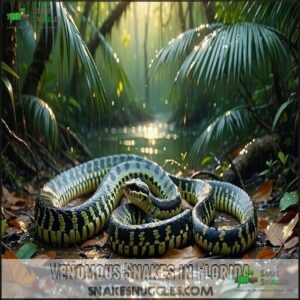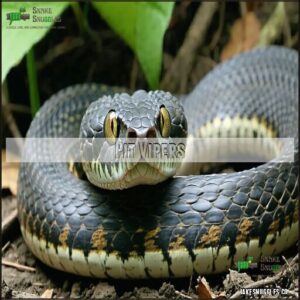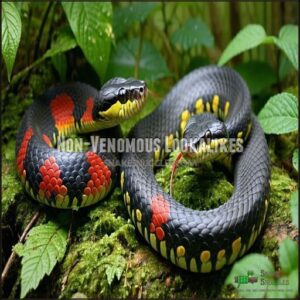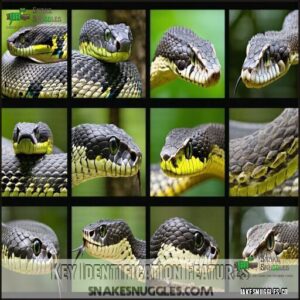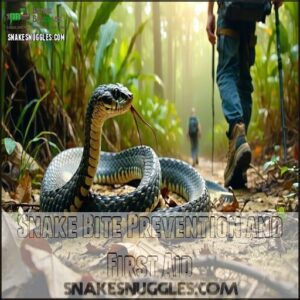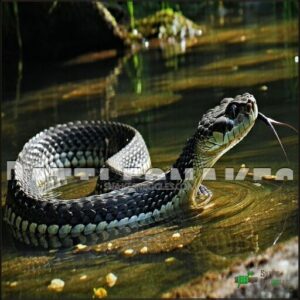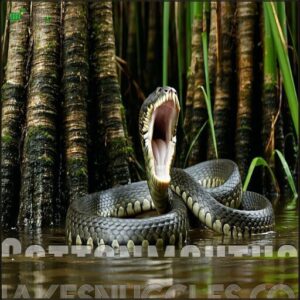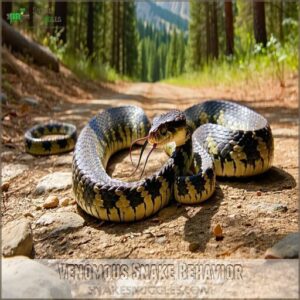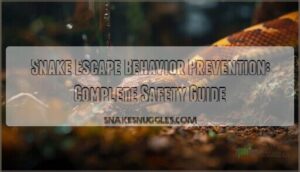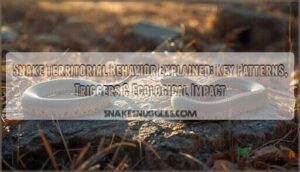This site is supported by our readers. We may earn a commission, at no cost to you, if you purchase through links.
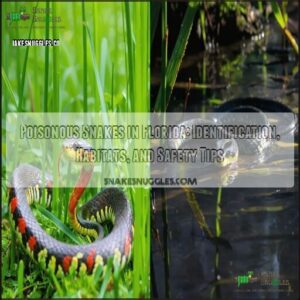
You’ll find the Eastern diamondback rattlesnake, timber rattlesnake, dusky pygmy rattlesnake, cottonmouth (aka water moccasin), copperhead, and the colorful Eastern coral snake.
Each has distinct features; for instance, rattlesnakes have, well, rattles, and coral snakes follow the rhyme: “Red touches yellow, kill a fellow.”
These snakes thrive in diverse habitats, from swamps to forests, but they’re not out to chase you down.
If you spot one, give it space.
Knowing these neighbors can help you stay calm and confident when exploring.
Table Of Contents
- Key Takeaways
- Venomous Snakes in Florida
- Snake Habitats and Distribution
- Identifying Venomous Snakes
- Snake Bite Prevention and First Aid
- Types of Venomous Snakes
- Frequently Asked Questions (FAQs)
- What is the most common poisonous snake in Florida?
- How to tell a poisonous snake?
- What happens if you are bitten by a coral snake?
- Are black mambas found in Florida?
- How to tell if a snake is venomous in Florida?
- What is the treatment for snake bites?
- How common are snake bites in Florida?
- Can venomous snakes be kept as pets?
- What attracts snakes to residential areas?
- Are there coral snake mimics in Florida?
- Conclusion
Key Takeaways
- You’ll find six venomous snakes in Florida, including rattlesnakes, cottonmouths, and coral snakes—each with unique features to watch for.
- Pay attention to distinct traits like rattles, triangular heads, or the coral snake’s “red touches yellow” pattern for easy identification.
- Stick to trails, wear boots, and avoid tall grass or debris piles to reduce your chances of encountering a snake.
- If bitten, stay calm, avoid moving the bite area, and seek immediate medical attention—time is critical.
Venomous Snakes in Florida
Florida is home to six types of venomous snakes, including rattlesnakes, cottonmouths, and coral snakes.
Knowing how to identify these species could help you stay safe while exploring the state’s diverse outdoors.
Eastern Diamondback Rattlesnake
The eastern diamondback rattlesnake is Florida’s largest, deadliest venomous snake.
Known for its potent venom and bulky frame, this snake is both fascinating and fearsome. It features a distinctive diamond pattern, perfect camouflage in its sandy habitats.
Here’s what makes the Eastern Diamondback stand out:
- Diamondback Venom: Stores enough to immobilize large prey, with effects deadly to humans.
- Rattlesnake Behavior: When threatened, coils defensively and shakes its rattle like maracas.
- Diamondback Size: Can reach up to eight feet long, weighing 10 pounds.
Remember, these rattlesnakes prefer avoiding humans—be cautious and give them space!
Timber Rattlesnake
What makes the Timber Rattlesnake stand out?
Its identifying marks include a reddish-brown stripe and dark chevrons.
This venomous snake thrives in timber habitats but faces threats due to habitat loss.
Its venom potency is no joke—seek immediate bite treatment! Their venom contains potent snake venom serine proteases.
Check its conservation status below:
| Feature | Details |
|---|---|
| Venom Potency | Highly potent, fatal risk |
| Habitat | Forests, flatwoods |
| Conservation | Declining population |
Dusky Pygmy Rattlesnake
The dusky pygmy rattlesnake is one of Florida’s smallest venomous snakes, maxing out at around 2 feet long.
Its identifying features include a thick body, dark brown spots on a gray background, and a faint rattle resembling buzzing insects.
Despite its size, its venom potency can cause painful bite symptoms.
With varied habitat preferences, it’s best to admire this rattlesnake from a safe distance.
Eastern Coral Snake
The Eastern Coral Snake, part of the Elapidae family, is shy yet dangerous due to its potent neurotoxin.
Recognized by red/yellow bands (remember: "red touch yellow, kill a fellow"), it’s often confused with mimicry snakes.
Despite its docile nature, bites can stop the heart or lungs.
Found in dry Florida habitats, proper snake identification is essential for safety.
Copperhead Snake
Copperhead snakes, part of the pit vipers family, are found in Florida’s northwestern floodplain forests. With distinctive copper-red heads and hourglass-shaped markings, these venomous snakes are hard to miss. Though generally calm, they’ll coil and reveal their fangs if threatened.
- Habitat: Moist areas, especially forests and wetlands.
- Behavior: Non-aggressive but defensive when provoked.
- Venom Effects: Rarely fatal but painful, affecting muscles and blood.
- Diet: Mice, frogs, and small rodents.
Spot one? Appreciate from a distance—don’t risk it.
Snake Habitats and Distribution
You’ll find venomous snakes across Florida, from the dense wetlands of the Everglades to drier forests and urban areas.
Their habitats depend on the species, so knowing where they’re most likely to hide can help you stay safe.
Florida Panhandle
The Florida Panhandle hosts some of the state’s venomous snakes, including Copperhead habitat and Timber distribution in wooded and coastal areas.
Copperheads and Timbers thrive in the Panhandle’s wooded and coastal areas–watch your step in their hidden habitats!
Panhandle snakes like these are best avoided by practicing snake safety, such as wearing sturdy boots and staying alert in their territory.
Panhandle Rattlesnakes and other Florida snakes pose risks, so understanding venomous snakes and preparing for potential snake bites can prevent serious harm. Many snakes in Florida control rodent populations, which helps to balance the local ecosystem.
The Everglades
The Everglades ecosystem is a dynamic snake habitat influenced by conservation efforts and water quality.
Venomous snakes like the coral snake live here alongside invasive species like Burmese pythons.
Exploring the wetlands, you’ll find:
- Mangrove forests teeming with wildlife
- Rich biodiversity shaped by ecotourism impacts
- Swampy lowlands perfect for Florida snakes
- Venomous species, adapting to changing Everglades conditions
Central Florida
In Central Florida, snake species thrive due to the region’s species abundance and varied habitats.
Venomous snakes favor wetlands, while non-venomous snakes often inhabit drier areas.
Urban encounters are common near backyards and places like Lake Jesup, where water snakes flourish.
Habitat loss increases tourist impact on snake behaviors, so wear boots outdoors and know snakebite treatment basics to stay safe.
Miami
Miami’s lush landscapes and growing urban areas create urban encounters with Miami-Dade snakes.
To stay safe, follow these tips:
- Wear closed-toe shoes while exploring coastal habitats.
- Stick to clear paths to avoid hidden Florida wildlife.
- Clear debris near homes to prevent nesting.
- Seal gaps to block indoor access.
- Know snakebite treatment for prompt action!
Stay aware and informed!
Southwest Florida
Southwest Florida’s coastal habitats and freshwater areas are prime spots for venomous snakes like the pygmy rattlesnake and coral snake.
Watch for cottonmouths near streams—they’re bold defenders of their turf!
Urban encounters with rattlesnakes are rare, but snake bites can spike with seasonal activity.
Exploring island populations? Stay alert!
Conservation efforts help protect snakes, so understanding their behaviors guarantees safer outdoor adventures.
Identifying Venomous Snakes
You can tell venomous snakes apart by focusing on key traits like head shape, eye structure, and color patterns.
Learning these details helps you stay safe and avoid confusing dangerous species with harmless ones. Learning these details helps you stay safe and avoid confusing dangerous species with harmless ones.
Pit Vipers
Pit vipers, like rattlesnakes and copperhead snakes, are fascinating yet dangerous due to their hemotoxic venom, which destroys tissue and blood cells.
You’ll spot them by their thick necks, keeled scales, and heat-sensing pits on their heads.
One key identifier is their elliptical pupil shape.
Here’s what to look for:
- A wedge-shaped, blocky head
- Heavy, muscular body for its size
- Rough-textured scales that appear matte
- A dark band running from eye to jaw (except copperheads)
If you stumble on one, stay calm, back away slowly, and skip becoming a “snake whisperer”!
Coral Snakes
The Eastern Coral Snake, part of the Elapidae family, is a master of stealth in Florida’s drier areas.
Its neurotoxic venom packs a punch, but the creature’s shy, nocturnal habits often keep it hidden.
Use this table to understand more:
| Habitat | Behavior | Venom Type |
|---|---|---|
| Dry areas | Secretive | Neurotoxic |
| Forests | Ambush | – |
| Wetlands | Rarely seen | – |
| Swamps | Solitary | – |
Spot it by its famous “red touch yellow” markings!
Non-Venomous Lookalikes
Harmless snakes, like the Scarlet Kingsnake or Water Snakes, often mimic venomous species, tricking predators and people alike.
With similar snake coloration and markings, identification mistakes are common.
Corn Snakes and others use harmless mimicry to appear dangerous.
Learning snake identification helps you tell poisonous vs venomous apart and safely distinguish snake lookalikes from their deadly counterparts.
Key Identification Features
Identifying venomous snakes in Florida starts with observing key features like scale patterns, head shape, and distinct snake colors.
Look for unique snake markings such as bands or spots.
Notice banding order—it’s key for distinguishing coral snakes from lookalike species. A rattlesnake’s rattle presence is a giveaway too.
Remember, snake identification challenges are common, so rely on a guide for tips and confidently avoid dangerous encounters!
Proper identification is key, so consider purchasing identification tools.
Snake Bite Prevention and First Aid
Protecting yourself from snake bites is all about staying alert, wearing proper gear, and knowing where snakes like to hide.
If you’re ever bitten, staying calm and seeking immediate medical help can make all the difference.
Safety Precautions
When hiking or working outdoors, staying alert is your best defense against snake bites. Avoid tall grass or reaching under logs without checking for snakes. Wear sturdy boots and pants as a barrier. Having a snake bite kit can provide essential tools for immediate response.
- Safe Hiking: Stick to clear trails, and avoid stepping into blind spots.
- Yard Maintenance: Keep grass trimmed, and remove debris piles.
- Pet Safety: Supervise pets outdoors to prevent snake encounters.
Snake Bite Symptoms
After a snake bite, initial symptoms like sharp pain, redness, and swelling often appear quickly.
Venom effects can escalate, causing tissue damage, numbness, or systemic reactions like difficulty breathing or blurred vision.
Neurotoxic venom, in particular, can lead to dangerous shock.
Monitor these snake symptoms closely, as untreated bites may worsen.
Remember, recognizing snake bite symptoms early is key for effective snake bite treatment.
First Aid Procedures
If bitten, stay calm and keep still to lower Bite Severity.
Remove jewelry, wash the area gently, and avoid Tourniquet Application or ice.
Cover the wound with a clean bandage. Consider stocking up on essential wound care for emergencies.
Snake venom symptoms vary, so steady yourself and call for help immediately.
Snake first aid buys time for snake bite treatment, like Antivenom Usage, at a hospital.
Medical Attention
After performing first aid, get to the hospital immediately for snakebite treatment. Time is critical with snake envenomation, especially for kids. Doctors assess bite severity to decide on antivenom availability and treatment options.
- Call poison control while on your way.
- Describe the snake’s look, if possible.
- Expect wound cleaning and monitoring for long-term effects.
- Recovery depends on pediatric considerations and bite severity.
- Schedule follow-ups to make certain proper healing and minimize complications.
After a bite, remember to remove tight fitting jewelry to prevent complications.
Types of Venomous Snakes
Florida is home to six venomous snake species, each with distinct traits and behaviors.
Knowing how to identify them can help you stay safe and appreciate these remarkable reptiles from a distance.
Rattlesnakes
Florida is home to three rattlesnakes: eastern diamondback, timber, and dusky pygmy.
Each uses its iconic rattle to warn threats.
The eastern diamondback rattlesnake, with its potent venom, claims the title of Florida’s most lethal.
Timber rattlesnakes favor northern habitats, while dusky pygmies stay smaller.
Hemotoxic venom causes significant tissue damage.
Rattlesnakes play key ecological roles despite common myths.
Cottonmouths
A Florida Cottonmouth, also called a water moccasin, is a thick-bodied pit viper often found near swamps, ponds, and lakes, thriving in aquatic habitats.
When threatened, it dramatically flashes its white mouth – an unmistakable warning.
Cottonmouth venom destroys blood cells, making bites dangerous.
Known for bold behavior, these snakes may coil and strike.
Confuse them with lookalikes? Look closely at their dark bands and patterns.
Copperheads
The copperhead, a member of the pit viper family, is found primarily in Florida’s northern panhandle.
Its tan body with dark brown hourglass-shaped markings blends perfectly with woodland habitats, its preferred hunting ground for small mammals and amphibians.
Recognized by its striking copper-colored head, the copperhead is often misunderstood, as its markings can resemble nonvenomous snakes.
While copperhead venom isn’t the most potent among venomous snakes, it can still cause pain and swelling if bitten.
These snakes typically reach 2-3 feet in length and are best admired from a safe distance.
Venomous Snake Behavior
Venomous snakes in Florida show fascinating behavior.
They rely on hunting strategies like ambushing prey and precise venom delivery for survival.
Defensive mechanisms include hissing, rattling, or striking if threatened, while mating rituals typically occur during warm seasons.
Their activity patterns vary; some are nocturnal hunters.
Understanding snake behavior, from defense postures to snake venom effects, helps you stay safe outdoors.
Frequently Asked Questions (FAQs)
What is the most common poisonous snake in Florida?
The cottonmouth, or water moccasin, is the most common venomous snake in Florida.
You’ll often find it near water, where its stout body and distinctive gape display warn you to keep your distance.
How to tell a poisonous snake?
“When in doubt, stay out!”
You can spot a venomous snake by its triangular head, vertical pupils, and heat-sensing pit near the eyes.
Bright warning patterns, like red-yellow banding, often signal danger–always observe safely!
What happens if you are bitten by a coral snake?
If a coral snake bites you, its neurotoxic venom can paralyze your muscles, potentially stopping your breathing.
Stay calm, call 911 immediately, and avoid moving the bite area to slow venom spread.
Time’s critical!
Are black mambas found in Florida?
Picture stepping into a movie about exotic creatures—only it’s Florida, not Africa.
Black mambas aren’t found here, so you’re safe from their lightning-fast strikes.
Stick to avoiding Florida’s actual six venomous snake species instead.
How to tell if a snake is venomous in Florida?
Watch for traits like triangular heads, vertical pupils, and heat-sensing pits between the eyes and nose.
Bright color patterns, like red touching yellow on coral snakes, also warn of venom.
Always give snakes space.
What is the treatment for snake bites?
Treat a snake bite like a ticking clock—get medical help fast.
Keep the bite low, stay calm to slow venom spread, and avoid cutting the wound or sucking venom.
Time is your best ally!
How common are snake bites in Florida?
In Florida, snake bites aren’t too common, averaging about 300 annually.
Venomous bites are rarer but possible.
Staying alert, avoiding tall grass, and watching where you step can easily reduce your chances of encountering trouble.
Can venomous snakes be kept as pets?
Keeping venomous snakes as pets is like juggling fire—it’s dangerous and heavily regulated.
You’ll need specialized permits, secure enclosures, and expert knowledge.
Even experienced handlers risk accidents. It’s not a hobby for the faint-hearted.
What attracts snakes to residential areas?
Snakes are drawn to residential areas by food, water, and shelter.
Tall grass, cluttered yards, woodpiles, and abundant rodents make ideal habitats.
Minimize these attractants to discourage unwelcome slithery visitors and keep your space less inviting!
Are there coral snake mimics in Florida?
Sometimes nature plays dress-up!
You’ll find harmless scarlet kingsnakes and milk snakes mimicking coral snakes in Florida.
Their similar red, black, and yellow patterns confuse predators—but remember, "red touches black, friend of Jack!
Conclusion
Think of Florida’s venomous snakes as nature’s high-voltage wires—fascinating but best admired from a safe distance.
By learning to identify the poisonous snakes in Florida, like rattlesnakes, cottonmouths, and coral snakes, you’ll better navigate their habitats, whether hiking swamps or strolling forests.
Remember, they’ve got no interest in chasing you down.
Keep your eyes peeled, stick to trails, and wear boots.
If bitten, stay calm and seek medical help quickly.
Knowledge keeps your outdoor adventures safe and enjoyable! Knowledge keeps your outdoor adventures safe and enjoyable!

